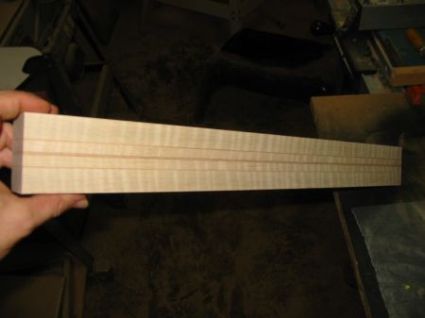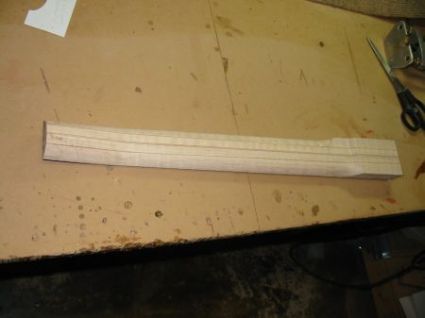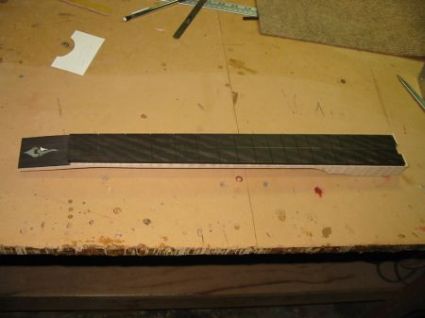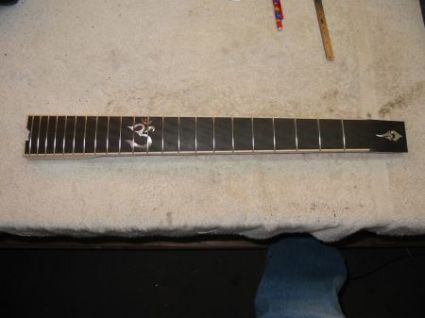Making the Forshage Hollow Body Guitar – Building the Neck
As promised, in my previous Forshage guitar article, here is the first installment in the making of the headless Forshage guitar. We’ll start with the guitar neck which is comprised of maple with an ebony fingerboard:

One of the first things you’ll note is the laminate neck construction. Chris explains his approach:
I laminate 4 pieces of soft maple together. The two outer pieces are book matches of each other and the two inners are book matches as well. This makes for a very stable neck. If any of the pieces want to warp in any direction, its mirror image wants to warp in the opposite direction, canceling out any potential movement. The laminating also adds some stiffness. What you get is about as stiff as rock maple but it sounds a little smoother, less harsh on the highs.
Here we see the neck much further along with its basic contours in place and an interesting detail which will become obvious in later pictures – a small “headstock” intended to address a common complaint about headless guitars – the lack of transition down around the first fret.

Chris has this to say about it:
I’m not crazy about the way headless guitars feel at the end around first position so I made a little headstock with a bit of an angle that you can feel when you get to the end.
In the process, Chris makes the guitar friendlier for guitarists accustomed to traditional guitars. He accomplishes this in an aesthetically pleasing manner and without negatively affecting overall balance and size.
Moving along, we see the ebony fretboard and the stub “headstock”:

Finally, we see a great shot of the neck with its frets fitted and Chris’ lovely inlay work:

In the next installment, we’ll take a look at the guitar body during the build process. Thanks go out to luthier Chris Forshage of Forshage Custom Instruments and soon to be Forshage guitar owner Dr. Marc Ybaben of the jazz group The Marc Why Group for sharing the details of this instrument.
Cool! I love guitars. This looks like a great project. -Tina
Thanks for stopping by! The Forshage is quite an interesting design and I’m excited over the opportunity to present it to my readers.
nice blog
Thank you!
How does the extended singlecut neck joint work? Is the neck flat on one side and then carved to shape once its attached to the body, or is the neck fully carved and the body shaped to fit the neck?
I think there’s a good shot of the neck joint on this: http://elutherie.org/2007/04/the-forshage-hollowbody-electric-guitar.html thread.
Welcome to the blog Josh! I see Ray pointed out a good shot of the neck joint (thanks, Ray). Does that help?
UPDATE: Take a look at the latest post on Forshage guitars – Alan Barley’s Forshage Ergonomic Headless Guitar.
There’s an even better view of the contouring at the neck joint.
Chris (Forshage) recently completed a custom instrument that I commissioned and I can testify to his knowledge of the instrument and vast experience as a fine luthier. In my opinion, his attention to detail and passion for building guitars makes him one of the best luthiers in the industry today.He crafted a precision instrument with excellent playability, beautiful tonewoods and aesthetics, in addition to a timely delivery.
Thanks Chris.
I want to know how the whole hollow body guitar is made.
Thanks, Aaron